Acquisition of multidrug resistance by L1210 leukemia cells decreases their tumorigenicity and enhances their susceptibility to the host immune response
- PMID: 15692844
- PMCID: PMC11032906
- DOI: 10.1007/s00262-004-0588-7
Acquisition of multidrug resistance by L1210 leukemia cells decreases their tumorigenicity and enhances their susceptibility to the host immune response
Abstract
The use of antineoplastic drugs for cancer treatment is frequently associated with the acquisition of a multidrug-resistant (MDR) phenotype that renders tumoural cells insensitive to antineoplastics. It remains elusive whether the acquisition of the MDR phenotype alters immunological parameters that could influence the cell sensitivity to an eventual host immune response. We report that immunisation of syngeneic mice with gamma-irradiated L1210S (parental line) and L1210R (MDR phenotype) cells results in a significant rejection of subsequently implanted L1210R-based tumours, but not of the L1210S ones. Notably, L1210R tumours display a twofold reduction in vivo proliferative capacity and are less aggressive in terms of mouse survival than their sensitive counterparts. Also, analysis of surface expression of molecules involved in antigen presentation and cytokine activity revealed a slight increase in IFN-gamma receptor expression, a decrease of Fas molecule, and a fourfold up-regulation of MHC class I molecules in L1210R cells. Nonetheless, both cell lines were able to induce a cytotoxic response in syngeneic mice and were equally susceptible to cytotoxicity by splenic cells. Together, these findings indicate that acquisition of drug resistance by L1210 cells is accompanied by pleiotropic changes that result in reduced tumour proliferative capacity and tumorigenicity in syngeneic mice. Hence, immunological studies of MDR tumours may assist in the design of specific therapeutic strategies that complement current chemotherapy treatments.
Figures

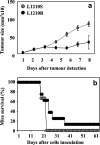
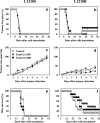
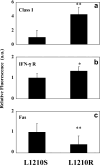
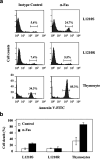
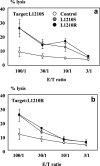
Similar articles
-
Cytotoxic activity of several unrelated drugs on L1210 mouse leukemic cell sublines with P-glycoprotein (PGP) mediated multidrug resistance (MDR) phenotype. A QSAR study.Neoplasma. 2000;47(2):100-6. Neoplasma. 2000. PMID: 10985475
-
Attenuated JNK signaling in multidrug-resistant leukemic cells. Dual role of MAPK in cell survival.Cell Signal. 2017 Jan;30:162-170. doi: 10.1016/j.cellsig.2016.12.003. Epub 2016 Dec 7. Cell Signal. 2017. PMID: 27940051
-
L1210 cells cultivated under the selection pressure of doxorubicin or vincristine express common mechanisms of multidrug resistance based on the overexpression of P-glycoprotein.Toxicol In Vitro. 2006 Dec;20(8):1560-8. doi: 10.1016/j.tiv.2006.07.011. Epub 2006 Aug 2. Toxicol In Vitro. 2006. PMID: 16962737
-
Suppression of NK-mediated natural resistance by interferon treatment of murine lymphomas.J Immunol. 1984 Apr;132(4):2129-34. J Immunol. 1984. PMID: 6199424
-
4-Demethoxy-3'-deamino-3'-aziridinyl-4'-methylsulphonyl-daunorubicin (PNU-159548), a novel anticancer agent active against tumor cell lines with different resistance mechanisms.Cancer Res. 2001 Mar 1;61(5):1991-5. Cancer Res. 2001. PMID: 11280757
Cited by
-
Immunological effect of local ablation combined with immunotherapy on solid malignancies.Chin J Cancer. 2017 Jun 7;36(1):49. doi: 10.1186/s40880-017-0216-5. Chin J Cancer. 2017. PMID: 28592286 Free PMC article. Review.
-
WNT Signaling in Tumors: The Way to Evade Drugs and Immunity.Front Immunol. 2019 Dec 20;10:2854. doi: 10.3389/fimmu.2019.02854. eCollection 2019. Front Immunol. 2019. PMID: 31921125 Free PMC article. Review.
References
-
- Azuma E, Masuda S, Qi J, Kumamoto T, Hirayama M, Nagai M, Hiratake S, Umemoto M, Komada Y, Sakurai M. Cytotoxic T-lymphocytes recognizing P-glycoprotein in murine multidrug-resistant leukemias. Eur J Haematol. 1997;59(1):14. - PubMed
-
- Bellamy WT. P-glycoproteins and multidrug resistance. Annu Rev Pharmacol Toxicol. 1996;36:161. - PubMed
-
- Bradley M, Zeytun A, Rafi-Janajreh A, Nagarkatti PS, Nagarkatti M. Role of spontaneous and interleukin-2-induced natural killer cell activity in the cytotoxicity and rejection of Fas+ and Fas− tumor cells. Blood. 1998;92(11):4248. - PubMed
-
- Cao X, Chen G, He L, Zhan W, Yu Y, Wang J. Involvement of MHC class I molecule and ICAM-I in the enhancement of adhesion and cytotoxic susceptibility to immune effector cells of tumor cells transfected with the interleukin (IL)-2, IL-4 or IL-6 gene. J Cancer Res Clin Oncol. 1997;123:602. - PubMed
Publication types
MeSH terms
Substances
LinkOut - more resources
Full Text Sources
Research Materials
Miscellaneous

